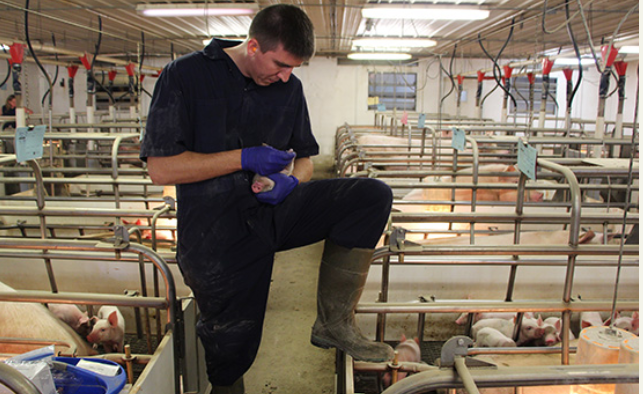



Tackle post-weaning E. coli issues with aggressive cleaning, vaccination
Escherichia coli (E. coli) has been a severe disease in our industry for decades and continues to be prevalent today. It is a bacterium that commonly causes neonatal and post-weaning diarrhea. E. coli can create a severe economic impact due to mortality, decreased weight gain, vaccination cost and added nutritional components to slow down scours.
Many neonatal E. coli diarrhea issues are covered up by maternal vaccinations. Our biggest issues today occur in the post-weaning period when maternal antibodies aren’t available to stop severe diarrhea, down paddling pigs and septicemia.
Two major, post-weaning E. coli adhesin types are K88 and F18. It is important to distinguish the two types to know timing of the scours and how to protect your piglets post-weaning. K88 is most common in the early post-weaning phase while F18 tends to be 2-3 weeks into the nursery phase.
Factors causing post-weaning diarrhea
Post-weaning diarrhea is very common and can involve multiple factors, including the environment, disease pressure, feed, maternal immunity and the transition from milk to feed. The long and short of it is: To get a protected pig, you need a clean environment with good feed.
In many cases, it’s tough to tell which area is the shortfall when you have scour issues. E. coli can be both a pig-flow problem, which would be transferred from the sow farm to the nursery or wean-to-finish barn, or even a site-specific issue for post-weaning scours.
In the field, there are many cases where E. coli tends to be a site issue. No matter what pigs are put in the barn, the facility ends up with a post-weaning, E. coli scour. To combat this, we do a very thorough cleaning that includes floors, feeders and water lines. Cleaning water lines can be especially important for E. coli when the issue is site dependent.
How to eliminate E. coli in a barn
Here’s a regimen for eliminating E. coli from a nursery or wean-to-finish barn.
1. Start by adding citric acid or other acidifiers prior to the previous group moving out of the barn and prior to cleaning the barn. Administer it through a water medicator. This way the pigs draw it all the way to the nipple. Note: The first time you complete this, be careful because the nipples may plug with residue that’s built up in the water lines.
2. During downtime between turns, thoroughly clean by washing with hot-water pressure. Allow to dry and then disinfect with your chosen disinfectant.
Whitewash with hydrated lime. Apply a thick coat and, ideally, lift all feeders and gates. Focus on the bottom side of gates and water troughs.
3. While completing this very thorough washing, soak the water lines again with another acidifier. Soak for at least 12 hours. Next, pull off all nipples and soak in bleach for 6 hours minimum. Note: This washing process is time consuming so you may need extra downtime between turns.
While going through extensive cleaning, we usually invest in other options such as vaccinations, antimicrobial treatment or feed additives.
As with most swine production, it is not as clean as a research trial, but the goal is to fix the problem.
Solving a ‘strep’ case
E. coli cases always seem simpler when writing an article than in real life situations. Just the other day, a producer called me to discuss a “strep case” and had me out for a sick call.
During the site visit we saw about 35 down and paddling pigs in a barn of about 1,000 head. I did not see many scours, but upon closer examination, I noticed severely sunken eyes of the freshly dead pigs. After performing a necropsy, we noticed dark-red, inflamed intestines. This was a mistaken diagnosis of strep and was actually an E. coli break.
Now with a diagnosis it should be easy to treat, right? When sending in the diagnostics, the E. coli was resistant to everything except neomycin. There are a variety of medications that have been very effective against E. coli. You will need to do diagnostics to determine antibiotic sensitivity.
Vaccinate prior to weaning
Prevention is still the best option. Use a good sanitation program and build up an ample supply of colostrum and post-weaning protection by vaccination. Normally, maternal antibodies will be lost at weaning when pigs are going into a new environment that can be stressful.
The best-case scenario is to vaccinate the piglets as maternal antibodies wane and prior to seeing too high of a bacterial load of E. coli in the environment. One of the most successful ways to achieve this is, just prior to weaning, spray the udders of the sows with a vaccine and dye. There are several commercial vaccines available, and a lot of producers and clinics have had success with autogenous vaccines.
If you do not own the sows and just buy weaned pigs, another option is to vaccinate the piglets on entry to the nursery. Be sure if you use any feed medication that it will not interfere with the vaccine.
With E. coli resistance becoming an industry-wide issue, producers and veterinarians have to find alternative approaches to reducing E. coli’s impact on growing pigs. By focusing on sanitation, diet and vaccination timing, there are many options to build a detailed plan to prevent E. coli outbreaks.






